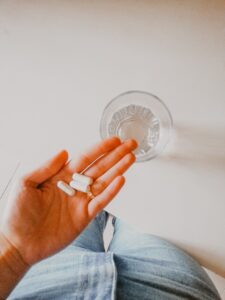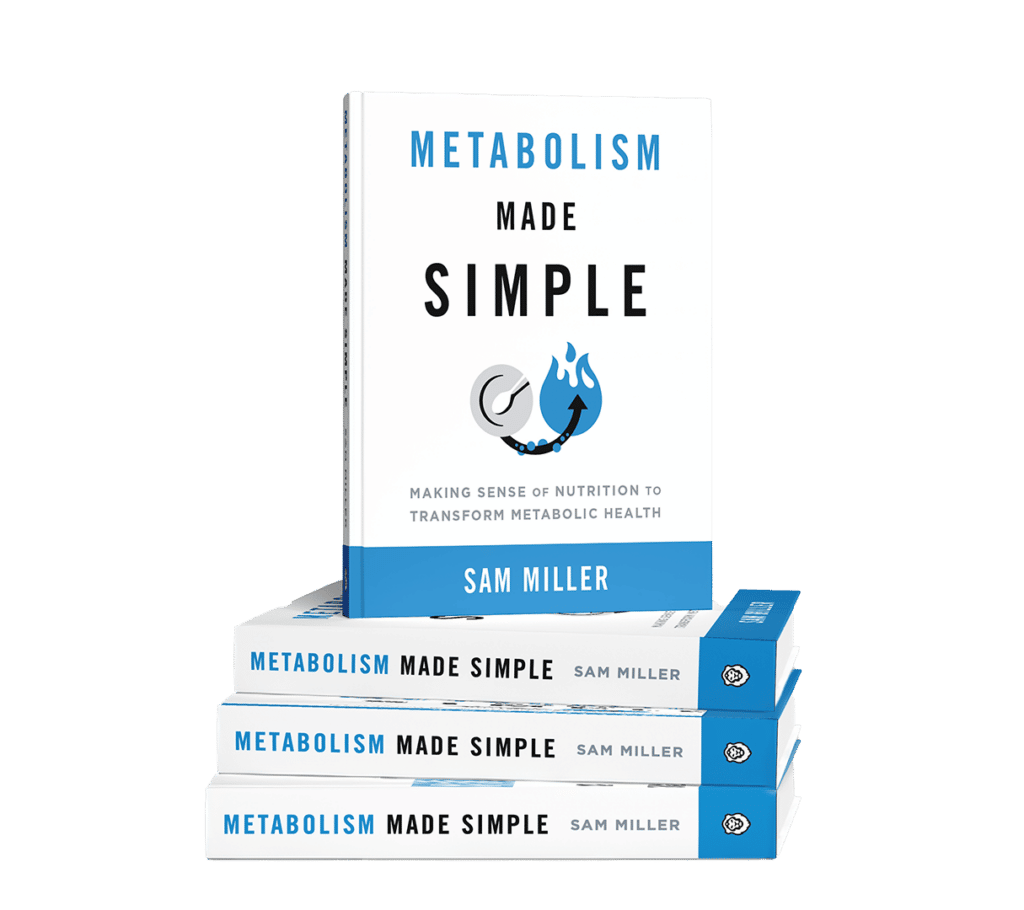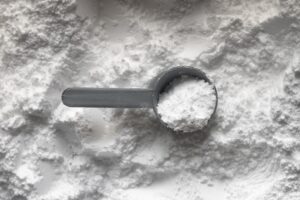Sodium has gotten a lot of flack over the years. For fifty years or more, we’ve been told to reduce our sodium intake for lower blood pressure and lower overall cardiovascular risk factors. However, the world of nutrition is a little more nuanced than that and these types of blanket recommendations almost never pan out for everyone.
So today, we’ll discuss how sodium impacts health.
Sodium is an integral electrolyte that’s 100% necessary for a lot of different functions in the body; from nerve impulses and muscle function to controlling fluid volume in your bloodstream.
Although salt-sensitive hypertension does exist and does have a genetic component, in most cases it’s a result of other health conditions. For the majority of healthy individuals, reducing sodium intake may actually cause more harm than good.
This blog post will answer a lot of the common questions fitness and nutrition coaches get from their clients about sodium intake. Questions you might get, particularly from clients worried they have too much sodium intake, include:
- Where did the current sodium guidelines come from?
- Where did the “fact” that increased sodium leads to high blood pressure come from?
- What does the data about sodium and blood pressure say?
- What could make someone susceptible to salt-sensitive hypertension?
- What are the dangers of too low sodium intake?
- How to figure out how much sodium should you have daily?
Table of Contents
Since this is a lengthier post, I’ll provide a summary first.
Summary:
- The salt and blood pressure connection is based on a hypothesis of scientific principles as well as correlational and circumstantial data that didn’t hold up as well as science has evolved.
- Salt-sensitive high blood pressure does exist and it can be caused by insulin resistance, very low potassium intake, and certain genetic variants.
- The dangers of lower sodium intake in healthy individuals include high insulin levels (possibly leading to insulin resistance), higher heart rate, stress on the kidneys and adrenals, decreased exercise performance, and increases in triglycerides and cholesterol.
- A healthy, insulin-sensitive individual with everything average – activity levels, average split macros, etc., should be fine taking in between 3,500 and 6,000 mg of sodium per day. However, this figure is relative, read on if you want specific recommendations for specific circumstances.
Does Too Much Sodium Cause High Blood Pressure
One of the main things nearly everyone thinks about when they think about salt and its possible negative effects is high blood pressure.
Where did the salt-blood pressure connection come from? Surprisingly, not from strong data on outcomes with salt and blood pressure. In other words, not actually from testing if salt raised blood pressure in randomized, clinically controlled trials.
There were some weak observational studies at the time, but they mainly came from a hypothesis based on foundational scientific principles. Mechanistic thinking based on principles can be quite helpful in some cases, but it can occasionally be misleading or not actually pan out that way in real-life circumstances, which is what’s going on when looking at how sodium intake impacts blood pressure.
Let’s look at the original salt-blood pressure hypothesis. The theory states that when we eat salt, we also get thirsty, so we drink more water. In the salt-high blood pressure hypothesis, that excess salt then causes the body to hold on to that increased water in order to dilute the saltiness of the blood. Then, the resulting increased blood volume would automatically lead to higher blood pressure.
Nothing in that statement is inherently wrong, except for the last sentence. Sodium does cause increased water retention, but a healthy person will balance out quite quickly.
There was some circumstantial evidence around that time to support the hypothesis. Data was gathered on salt intakes in various populations, and in some cases, correlations between higher sodium intake and blood pressure were seen.
However, correlation does not mean causation. Correlation simply means that two variables change together, which, in this case, was that people who had higher sodium intake also had high blood pressure. The increased sodium intake didn’t necessarily cause the increased blood pressure.
Way too many of our nutritional faux pas these days are because we try to draw causation from correlation and then base entire nutritional guidelines on that, which is why you, the savvy fitness coach, are doing your research to determine which nutritional guides are accurate and which are myths.
Does Salt Intake Affect Blood Pressure?
The burning question is, what does the more recent and more comprehensive data say about the impacts of high sodium intake on blood pressure?
What we actually see in most healthy individuals is that increased salt intake causes a fleeting, passing, and inconsequential rise in blood pressure that goes away quite quickly.
For a few stats, evidence in the medical literature suggests that approximately 80% of people with normal blood pressure (less than or equal to 120/80) are not sensitive to the blood pressure-raising effects of salt at all.
Among those with prehypertension (at risk of high blood pressure), roughly 75% are not sensitive to salt, and even among those with full-blown hypertension, about 55% are totally immune to salt’s effects on blood pressure.
How Can Sodium Increase Blood Pressure
While a high sodium diet isn’t a guarantee of high blood pressure, it’s still possible for individuals to experience sodium-sensitive hypertension.
Basically, sodium-sensitive hypertension has been blamed on the wrong white crystal; the real culprit here is sugar.
Insulin Resistance
For most people, consuming sugar in moderation is fine, but what I’m referring to here is the chronic overconsumption of it leading to insulin resistance. This is probably the most common factor.
Your body has very complex mechanisms for regulating your sodium balance. The kidneys are directed to either reabsorb sodium back into circulation or push it out in urine based on different hormonal factors.
In a healthy individual, an appropriate amount of salt is reabsorbed and an appropriate amount is excreted, leading to neutral effects on blood pressure
However, in cases of insulin resistance, we have a few factors causing the kidneys to reabsorb significantly more salt than they should. High insulin signals the kidneys to reabsorb sodium. Aldosterone also tends to be elevated in individuals with insulin resistance, and this hormone also causes the kidneys to reabsorb sodium and excrete potassium.
When we have this excess sodium in the blood without the ability to excrete it, then the salt-blood pressure hypothesis is true. The chronic increased fluid volume within the bloodstream will raise blood pressure.
Low Potassium Intakes Coupled with High Sodium Intakes
Blood pressure regulation is based on the balance of sodium and potassium within the body.
If someone’s potassium levels are low but sodium is high, this can lead to an increase in blood pressure.
This mainly occurs in cases of people eating the Standard American Diet. Most processed foods are very high in sodium but contain very little potassium. If someone’s diet is made up of even 50% high-sodium, low-potassium meals (often processed and restaurant foods), then they are at risk of high blood pressure.
However, if someone is eating mostly whole foods, potassium intake naturally rises.
Many whole foods are rich in potassium, and someone eating mainly whole foods is most likely getting enough potassium daily. Combine that with the fact that there’s minimal additional sodium content in whole foods, you can salt your food to taste and maintain sodium consumption within dietary guidelines.
As you can see, sodium and potassium intakes can impact blood pressure more than someone’s daily sodium intake alone.
Genetics
The genetic basis involves one of the factors we talked about earlier: aldosterone. The release of aldosterone is one of the final products of a system known as the renin-angiotensin-aldosterone system, or the RAAS system.
Simplified, this system is in place in order to regulate and raise blood pressure in cases of low blood pressure, such as dehydration, blood loss, or electrolyte imbalances. However, research has found that a particular genetic variation in the ACE gene leads to increased aldosterone release, which could contribute to salt-sensitive high blood pressure.
Those are some of the main factors that could cause someone to be salt-sensitive hypertensive. Two of the potential causes are totally lifestyle-based, and the other is on the rare side.
Dangers of a Low Sodium Diet
Yes, despite all the fear-mongering about eating too much sodium, it is possible to consume too little sodium, which has its own health concerns.
Sodium reduction is not always the answer to high blood pressure.
Let’s now dive into the potential dangers of restricting salt intake too much.
Increased Heart Rate
One of the larger dangers of restricting salt intake is increased heart rate.
When you restrict salt intake, your blood fluid volume goes down. When this happens, the RAAS system we talked about earlier activates, and this causes increases in aldosterone to maintain blood pressure, but it also causes increases in epinephrine and norepinephrine. These are the primary hormones of the sympathetic nervous system, which, when increased, also increase your heart rate.
In some cases, heart rate can raise as much as 25% in an individual who doesn’t get enough dietary sodium. This increase in heart rate, if it lasts a prolonged period, will increase the risk of cardiovascular disease and cardiac events.
Dietary sodium reduction may seem like the best way to avoid heart disease and keep blood pressure levels low, but it can actually have the opposite effect.
Raises Insulin Levels
When you have reduced sodium intake, your body has compensation mechanisms to ensure that you still have enough sodium within the body, and one of these mechanisms is a rise in insulin levels.
As we talked about earlier when we talked about salt-sensitive hypertension, insulin acts at the kidneys to help retain salt, so, in effect, reduced sodium intake causes the body to elevate basal insulin levels in order to help retain more salt in the kidneys.
However, higher basal insulin levels have knock-on effects on a lot of other things and are one reason why, when some people reduce sodium intake, they begin to have a lot of sugar cravings. Higher insulin floating through the bloodstream is directly damaging to the endothelial lining (the lining of the arteries) and is a major risk factor for atherosclerosis (thickening or hardening of the arteries caused by a buildup of plaque in the inner lining of an artery).
If allowed to go on long enough, dietary sodium restriction can lead to insulin resistance and raise the risk for metabolic syndrome and Type 2 Diabetes.
Kidney and Adrenal Stress
The kidneys, at a simplified level, are a fantastic filter. The human body has, on average, 1 to 1.5 gallons of blood, and the kidneys filter this entire volume of blood around 40 times per day, which results in around 3.2 to 3.6 pounds of salt filtered per day.
The real kidney stress occurs when the kidneys have to significantly ramp up their salt reabsorption. This process is taxing and actively requires the body to expend calories (not a good thing in this instance) to complete the process, so if you’re consistently eating foods with low sodium content, this can stress the kidneys over time.
While lowering sodium intake won’t lead to chronic kidney disease, you can still experience negative health effects on the kidneys if you don’t have adequate intake.
As far as the adrenals, as we talked about earlier, a low salt diet will increase the levels of epinephrine and norepinephrine in the blood, and if sodium levels are quite low, this will also increase cortisol (your stress hormone). Therefore, a long-term salt-restricted diet could potentially cause more adrenal stress than we want.
Triglycerides and Cholesterol
Increases in triglycerides and LDL cholesterol are consistently seen in randomized controlled trials (the gold standard of studies) that restrict salt.
Even as far back as the original DASH trial that spawned the DASH diet (this was one of the first sodium-restricted diet protocols). In that trial, only modest reductions in blood pressure were seen by reducing dietary sodium in already hypertensive individuals, but triglycerides and LDL increased significantly.
Just for another example, in a 2012 randomized controlled trial comparing different salt intakes, the group with the lowest sodium intake only had a 1% reduction on blood pressure in hypertensives and no decrease in individuals with normal blood pressure, but there was a consistent 7% increase in triglycerides.
Triglycerides are one of the more important markers on a lipid panel, and elevated levels can indicate insulin resistance. Insulin levels play highly into triglyceride levels, so this makes sense if the diet was also raising the insulin levels.
This all may sound a little bit scary, but it is really only seen in salt-restricted states, which just so happens to fall around or below the current dietary guidelines for Americans for salt intake, which are 2,300 mg/day.
Yes, a lot of those above effects have occurred at sodium intakes between 1,500–2,300 mg/day, which has spurred a lot of controversy in the scientific world with a lot of prominent experts pushing to increase the sodium dietary guidelines for Americans.
What Should Your Daily Sodium Intake Be?
Most things in nutrition are individualized and sodium intake is no different, so how do you know how much sodium you should take in every day? This depends on a lot of factors.
The average healthy individual (good insulin sensitivity, etc.) with average activity levels, eating moderate macros all the way around would be totally fine on 4,000–6,000 mg/day — 5000 mg of sodium might be a good sweet spot for your usual sodium intake.
However, there are other factors that may increase your need for salt:
Remember, one of the things that causes sodium retention in the kidneys is insulin. We then have to think about when insulin levels would be very low; one of those situations would be when someone is following a ketogenic diet.
The Keto Diet Causes Sodium Wasting
If someone eats a very low-carb or ketogenic diet, their daily sodium intake recommendation would increase to around 7,000–8,000 mg as a baseline, and even more if they’re highly active since the kidneys waste a lot of sodium when insulin levels are rock bottom.
Sodium intake should be especially paid attention to once someone transitions into a very low-calorie or keto diet strategy from a mixed diet. During the transition period, the kidneys waste even more sodium since the kidneys haven’t adapted to the new state yet.
After about a month, the kidneys start conserving a bit more sodium, but the person will still need a relatively higher salt intake compared to a mixed diet.
Chronically Low Calorie
The reason behind needing a high salt intake when eating chronically low calories is much the same as the last one; low insulin. If someone has been underfeeding themselves compared to their energy expenditure and is very lean, insulin is going to also be at a rock bottom state.
Obviously, the best move here is to increase calories and reverse diet, but if it’s a situation where that’s not available yet, such as someone is dieting hard for a photoshoot or competition, then sodium needs will be higher. Probably not to the same level as a ketogenic diet, but close.
Untreated Hypothyroidism or Adrenal Insufficiency
Untreated hypothyroidism causes a decrease in cardiac output, and with that, anti-diuretic hormone (ADH) levels increase. ADH is another fluid balance hormone. When ADH is elevated, we retain water, and when it’s low, we let go of water.
Connecting that to sodium, as ADH levels increase, this decreases the ability to excrete water and regulate sodium levels in the blood correctly. In addition to that, it’s been observed that some hypothyroid patients have higher urinary sodium excretion as well. This can be mitigated by treating the hypothyroidism; either the underlying issue causing it or with medication, or both.
In adrenal insufficiency, we see the exact same mechanism. If someone is cortisol deficient, ADH rises in order to compensate, and then we have the whole process we just explained happening again.
Higher Levels of Exercise
The level of increased sodium you may need depends on the length of exercise and how much you’re sweating. I do have a podcast on hydration where I talk about how everyone has a different level of salt that they sweat out during exercise.
Some people excrete a significant amount of salt during exercise and some excrete less. If you get done exercising and you have this visible white residue on your clothes after they dry, you’re probably someone that excretes a little bit more than average.
With any exercise that causes you to sweat excessively, such as longer endurance exercise like running, swimming, rowing, Crossfit, and some high-volume resistance training workouts, its safe to go with the recommendation of 1,100–1,200 mg of sodium (½ tsp) per liter of water per hour.
Meaning, take a half tsp of sodium, mix it in a liter of water, and drink one of these sodium-infused liters per hour of intense exercise. These days, supplements like LMNT can help you do this in a tasty way.
However, if you’re just doing regular strength training and not sweating a lot, this probably isn’t necessary, but then again, it also probably wouldn’t hurt to do this as long as your food supply isn’t contributing to especially high levels of sodium (again, this is where eating a primarily whole-food diet is beneficial).
As we come to a close, there are certain signs you should look for to see if you’re low on sodium or need more sodium intake:
- Cold extremities
- Dark urine
- Decreased skin turgor (the skin remains “tented” when it is pinched)
- Decreased urine output
- Dry axilla (armpit or underarm) and tongue
- Poor capillary refill (takes longer than 2 seconds for the nail bed to return from white to pink after being pinched)
- Dizziness after rising from a seated or reclined position
- Salt cravings
- Syncope (loss of consciousness from low blood pressure)
- Thirst
Get Enough Sodium to Be Healthy
I’m hoping this has provided you with a little more clarity on how simple table salt can be a part of a healthy diet.
If you’re a healthy, active individual, then you shouldn’t shy away from dietary salt. It has performance-enhancing effects in exercise, keeps your heart rate normal, takes stress off the adrenals and kidneys, and is one factor in keeping insulin levels normal. Most healthy individuals do not have to stress about heart or kidney disease due to their dietary salt intake as long as it remains adequate.
While excessive sodium diets can have harmful effects on your health, it’s also important to remember that sodium reduction can also have negative consequences.
As always, aim for a healthy balance based on your current health conditions, diet, and lifestyle.
References
Andrew Mente et al. Associations of urinary sodium excretion with cardiovascular events in individuals with and without hypertension: a pooled analysis of data from four studies. The Lancet. ARTICLES| VOLUME 388, ISSUE 10043, P465-475, JULY 30, 2016. DOI:https://doi.org/10.1016/S0140-6736(16)30467-6
Graudal NA, Hubeck‐Graudal T, Jurgens G. Effects of low sodium diet versus high sodium diet on blood pressure, renin, aldosterone, catecholamines, cholesterol, and triglyceride. Cochrane Database of Systematic Reviews 2017, Issue 4. Art. No.: CD004022. DOI: 10.1002/14651858.CD004022.pub4. Accessed 09 February 2022.
Niels Graudal et al. Conflicting Evidence on Health Effects Associated with Salt Reduction Calls for a Redesign of the Salt Dietary Guidelines. Progress in Cardiovascular Diseases. Volume 61, Issue 1, May–June 2018, Pages 20-26. https://doi.org/10.1016/j.pcad.2018.04.008
Andrew Mente et al. Sodium Intake and Health: What Should We Recommend Based on the Current Evidence? Nutrients 2021, 13(9), 3232; https://doi.org/10.3390/nu13093232
Esteban Poch et al. Molecular Basis of Salt Sensitivity in Human Hypertension. 1 Nov 2001 https://doi.org/10.1161/hy1101.099479. Hypertension. 2001;38:1204–1209.
Graudal NA, Hubeck-Graudal T, Jürgens G. Reduced Dietary Sodium Intake Increases Heart Rate. A Meta-Analysis of 63 Randomized Controlled Trials Including 72 Study Populations. Front Physiol. 2016 Mar 24;7:111. doi: 10.3389/fphys.2016.00111. PMID: 27047393; PMCID: PMC4805644.
Liamis G, Filippatos TD, Liontos A, Elisaf MS. MANAGEMENT OF ENDOCRINE DISEASE: Hypothyroidism-associated hyponatremia: mechanisms, implications and treatment. Eur J Endocrinol. 2017 Jan;176(1):R15-R20. doi: 10.1530/EJE-16-0493. Epub 2016 Aug 2. PMID: 27484454.
Jessani N, Jehangir W, Behman D, Yousif A, Spiler IJ. Secondary adrenal insufficiency: an overlooked cause of hyponatremia. J Clin Med Res. 2015 Apr;7(4):286-8. doi: 10.14740/jocmr2041w. Epub 2015 Feb 9. PMID: 25699130; PMCID: PMC4330026.
James DiNicolantonio. The Salt Fix : Why the Experts Got it all Wrong–and How Eating More Might Save Your Life. New York : Harmony Books, [2017].
















